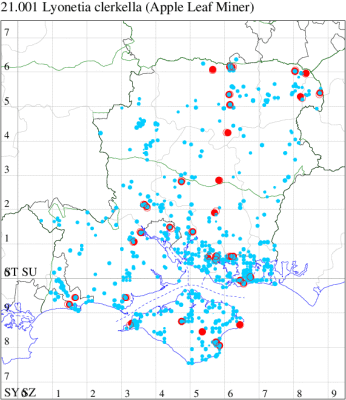2020 Annual Report for: Lyonetiidae / Lyonetiinae
For species seen in 2020 that had less than or equal to 100 records, full details are included; for more common species, the earliest, latest and highest count by vice-county are shown. The narrative for each species is taken from the main Hantsmoths website, and it is possible that some information on abundance and occurrence can get out of date, as it is impossible to keep up with all changes; however it should give a good introduction to each species. The tables in each species account summarise the previous status, and that for the current year.
For the maps, all records prior to 2020 are shown by a blue dot (the larger the dot, the more recent), with the current year's records shown in red. As previous records are superimposed on any report for 2020, new sites have greater emphasis (i.e. will show as 'more red').
In the species accounts, an asterisk next to a location indicates a new 10km square record; earliest ever dates are highlighted in orange, and latest ever in red. Initials in the species accounts refer to the recorders listed here. Please get in touch if you identify any omissions or errors, in particular if you have records that have yet to be submitted. Details of how to submit records can be found here.
21.001 [B&F: 0263] Apple Leaf Miner Lyonetia clerkella (Linnaeus, 1758) - Common
Common in hedgerows, gardens and orchards throughout much of the British Isles. In Hampshire and on the Isle of Wight common and widespread. Wingspan 8-9 mm. Larva mines leaves of Hawthorn, Apple, Wild Cherry, Bird Cherry, Birch, Cotoneaster and Rowan, causing sufficient damage to be a serious pest in some areas and can occasionally reach levels where localised economic damage is possible to fruit trees in Britain.
Records prior to 2020
| Vice County | #Records | #Individuals | First Record | Last Record |
|---|---|---|---|---|
| 10 | 339 | 646 | 1926 | 2019 |
| 11 | 3160 | 10416 | 1972 | 2019 |
| 12 | 402 | 504 | 1975 | 2019 |
2020 records
| Vice County | #Records | #Individuals | Max Quantity |
|---|---|---|---|
| 10 | 20 | 47 | 7 |
| 11 | 122 | 254 | 20 |
| 12 | 28 | 55 | 12 |

Records by year
Records by week (adult)
Records by week (larval)
Record Summary
VC10: Earliest: Shanklin, 01 Jun, 1 (IOu) Latest: Bembridge, 01 Oct, 0 (PBa) Max count: Shanklin, 24 Jun, 7 (IOu)
VC11: Earliest: Southsea, 06 Apr, 1 (JRL) Latest: Totton, 20 Sep, 1 (LH) Max count: Portsdown, 14 Sep, 20 (RJD)
VC12: Earliest: Farnborough, 21 May, 1 (KBW) Latest: Yateley Common, 15 Nov, 0 (JHH) Max count: Cholderton, 08 Aug, 29 (TJN, HE)
21.002 [B&F: 0262] Lyonetia prunifoliella (Hübner, 1796) - pRDB1
Formerly reported from the Midlands at Boughton, Worcestershire, Whittlebury Forest, Northamptonshire and near Stony Stratford, Buckinghamshire, and also from Worthing, Sussex, and it was fairly common in the late 19th Century (MBGBI Vol 2), it was not seen in the 1900's and was assumed to have become extinct. The first recent record appears to be in 2007, since when it has been encountered with increasing frequency in a number of counties including Dorset and Norfolk, perhaps following re-colonisation from the continent; the first Hampshire record was in 2014, since when it has been encountered with increasing regularity on the coast of Hampshire from Portsmouth to Hayling and on the south-eastern side of the Isle of Wight. The first North Hampshire record came in 2021, with another in 2023, and it will likely become more frequent inland. Wingspan 9-10 mm. The larva mines the leaves of various roseaceous trees, such as Blackthorn and apple, forming a gallery leading to a blotch. The pupal cocoon is suspended from silken 'guyropes' and closely resembles that of L. clerkella.
Records prior to 2020
| Vice County | #Records | #Individuals | First Record | Last Record |
|---|---|---|---|---|
| 10 | 6 | 35 | 2018 | 2018 |
| 11 | 15 | 9 | 2014 | 2019 |
2020 records
| Vice County | #Records | #Individuals | Max Quantity |
|---|---|---|---|
| 11 | 1 | 1 | 1 |

Records by year
Records by week (adult)
Records by week (larval)
Record Details
VC11: Portsmouth, one, 20 Aug (IRT)